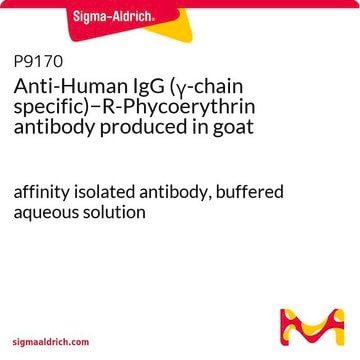52412
R-Phycoerythrin
BioReagent, passes test for gel electrophoresis
Sinonimo/i:
R-PE, phycobiliprotein
Autenticatiper visualizzare i prezzi riservati alla tua organizzazione & contrattuali
About This Item
Prodotti consigliati
Nome Commerciale
BioReagent
Concentrazione
≥10.0 mg/mL (UV)
tecniche
electrophoresis: suitable
Fluorescenza
λex 542 nm; λem 575 nm in 0.1 M phosphate pH 7.2
Compatibilità
passes test for gel electrophoresis
Temperatura di conservazione
2-8°C
Categorie correlate
Descrizione generale
R-Phycoerythrin or R-PE is a fluorescent probe belonging to the group of phycobiliproteins obtained from macroalgae. R-Phycoerythrin (R-PE) is a protein acting as a photosynthetic accessory pigment in red algae (Rhodophyta). It is an oligomeric protein of 240 kDa, with 6 α (about 20 kDa), 6 β (about 20 kDa), and 1 γ (about 30 kDa) subunits. Phycobiliproteins are water-soluble light-harvesting proteins with a high fluorescent property.
Applicazioni
R-Phycoerythrin (R-PE) is useful in the laboratory as a fluorescence-based indicator for the presence of cyanobacteria and a variety of immunofluorescence applications. R-PE is a useful fluoroprobe in various electrophoretic procedures. R-Phycoerythrin (R-PE) proteins detect mercury ions in soil and groundwater samples. Phycoerythrin has been widely used in food, cosmetics, immunodiagnostics, and analytical reagents.
Risultati analitici
The product is suspended in 150 mM sodium phosphate, 60% ammonium sulfate, 1 mM EDTA, 1 mM sodium azide, pH 7.0 and must be dialyzed against conjugation buffer or PBS before conjugation.A566/A280 >4.6, A620/A566 <0.03, A566/A498 <1.5
Codice della classe di stoccaggio
12 - Non Combustible Liquids
Classe di pericolosità dell'acqua (WGK)
WGK 1
Punto d’infiammabilità (°F)
Not applicable
Punto d’infiammabilità (°C)
Not applicable
Dispositivi di protezione individuale
Eyeshields, Gloves
Certificati d'analisi (COA)
Cerca il Certificati d'analisi (COA) digitando il numero di lotto/batch corrispondente. I numeri di lotto o di batch sono stampati sull'etichetta dei prodotti dopo la parola ‘Lotto’ o ‘Batch’.
Possiedi già questo prodotto?
I documenti relativi ai prodotti acquistati recentemente sono disponibili nell’Archivio dei documenti.
I clienti hanno visto anche
R Rossano et al.
Journal of biotechnology, 101(3), 289-293 (2003-03-05)
R-Phycoerythrin (R-PE) is a protein acting as a photosynthetic accessory pigment in red algae (Rodophyta). This protein has gained importance in many biotechnological applications in food science, immunodiagnostic, therapy, cosmetics, protein and cell labelling, and analytical processes. In this paper
Xiaobin Wang et al.
The Analyst, 144(12), 3892-3897 (2019-05-24)
Mercury, as one of the most prevalent toxic metals released by various natural and anthropogenic processes, causes severe pollution of soil and groundwater. In this work, R-phycoerythrin (R-PE) proteins encapsulated into ZIF-8 composite thin films were prepared via a solid-confinement
Hoda Hossein-Nejad et al.
The Journal of chemical physics, 136(2), 024112-024112 (2012-01-21)
We present a formalism to quantify the contribution of path-interference in phonon-mediated electronic energy transfer. The transfer rate between two molecules is computed by considering the quantum mechanical amplitudes associated with pathways connecting the initial and final sites. This includes
Justin D Cohen et al.
Chembiochem : a European journal of chemical biology, 13(6), 888-894 (2012-04-12)
A screen of Trp37 mutants of Escherichia coli lipoic acid ligase (LplA) revealed enzymes capable of ligating an aryl-aldehyde or aryl-hydrazine substrate to LplA's 13-residue acceptor peptide. Once site-specifically attached to recombinant proteins fused to this peptide, aryl-aldehydes could be
Lu-Ning Liu et al.
Journal of biotechnology, 116(1), 91-100 (2005-01-18)
Phycoerythrins have been widely used in food, cosmetics, immunodiagnostics and analytical reagents. An efficient one-step chromatography method for purification of R-phycoerythrins from Polysiphonia urceolata was described in this paper. Pure R-phycoerythrin was obtained with an absorbance ratio A(565)/A(280) of 5.6
Il team dei nostri ricercatori vanta grande esperienza in tutte le aree della ricerca quali Life Science, scienza dei materiali, sintesi chimica, cromatografia, discipline analitiche, ecc..
Contatta l'Assistenza Tecnica.







